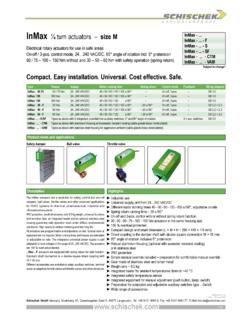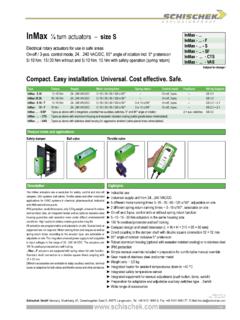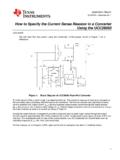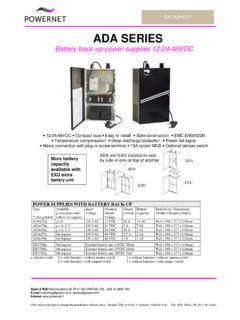Transcription of M AN761 - Microchip Technology
1 M AN761 . LDO Thermal Considerations The conservation of power, states that power in must Author: Paul Paglia, equal power out. Consequently, input power is equal to Microchip Technology Inc. the power delivered to the load plus the power dissipated in the LDO, (Equation 1): INTRODUCTION. EQUATION 1: Battery-operated equipment (most notably cell phones and notebook computers) have created a strong PIN = POUT + PLDO. demand for linear regulators in small packages. While such packages save space, they also have poor heat The power dissipation of the LDO is expressed in transfer characteristics. To minimize power dissipation, Equation 2: these regulators are designed to work with very low input/output voltage differentials, hence the name low EQUATION 2: dropout regulators or LDOs.
2 PD = (VIN VOUT) x ILOAD + VIN x IGND. LDOs specify maximum output current and input voltage limits, but blindly operating the LDO within these limits will surely result in exceeding the maximum When calculating power dissipation, it is critical that power dissipation capability. worst case conditions be used. This means maximum VIN, ILOAD, and IGND, and minimum V OUT values. DISSIPATING HEAT Equation 2 is more accurately written as Equation 3. Like other power devices, LDOs dissipate heat EQUATION 3: generated in the die by convection at rates determined by the thermal resistances in the system. Heat PDMAX = (VINMAX V OUTMIN) x ILOADMAX +. dissipation by convection is determined by the thermal VINMAX x IGNDMAX.
3 Resistance from the junction to ambient ( JA). Typically, heat sinks and/or forced air techniques may be used to decrease JA, but not without impacting system size EXAMPLE 1: and cost. The ( LDO in a TO-220-3. In addition to convection, heat is also removed from the package) is being used to regulate a 5V supply down to LDO by conduction ( , through any portion of the The 5V supply is specified to have an output package that is in contact with the circuit board). In this tolerance of 5%. The maximum load on the case, increasing copper trace size and improving supply is The system operating temperature thermal interface (using thermal grease or films) range is from 20 C to 70 C.
4 Significantly improves conduction cooling efficiency. Given: Maximum supply current = 130 A. LDO POWER DISSIPATION VINMAX = (5V x ) = VOUTMIN = Determining the power dissipated by an LDO involves a straight forward calculation. The current entering the Therefore, (Equation 4 and Equation 5). LDO can only go two places: through the pass device to the output (IOUT); or through the internal bias circuitry EQUATION 4: to ground (IGND). See Figure 1. PDMAX = ( ) x + x 130 A. IIN IOUT. LDO. VIN IN. EQUATION 5: VOUT. OUT PDMAX = IGND. FIGURE 1: LDO Power Dissipation 2002 Microchip Technology Inc. DS00761B-page 1. AN761 . THERMAL RESISTANCE. Heat Heat flows from a high temperature (T1) to a relatively Air lower one (T2) at a rate determined by the thermal resistance ( 12) between the two points (see Heat Sink Figure 2).
5 Package Die 12. T1 T2 FIGURE 3: Heat transfer Heat Flow The thermal resistance can now be written as shown in Equation 10. FIGURE 2: Thermal Resistance The thermal resistance is the temperature rise (in C) for EQUATION 10: every watt dissipated for the system in question. There- JA = JC + CS + SA. fore, the expression in Equation 6 and Equation 7. EQUATION 6: NO HEAT SINK. T1 T2 = PD x 12 If no heat sink is used, thermal resistance from junction to case is typically provided. EQUATION 7: EQUATION 11: 12 = (T1 T2)/PD JA = C/W. Where: T1 = Temperature of Point 1 EXAMPLE 2: T2 = Temperature of Point 2 Given: TO-220-3 JA = 53 C/W. PD = Power dissipated in the device Maximum Junction Temperature = 150 C.
6 And from Example 1: Relating this model to an IC, we can say that the device's thermal resistance from junction to ambient PDMAX = ( JA) is equal to the junction temperature minus TAMAX = 70 C. ambient, divided by power dissipation, or as expressed We can calculate the junction temperature under these in Equation 8. conditions by using Equation 9: EQUATION 8: TJ = ( JA x PD) + TA. TJ = C + 70 C. JA = (TJ TA)/PD. TJ = C. The device junction temperature can be expressed as This junction temperature is above the maximum limit. a function of power dissipation and thermal resistance The highest power dissipation allowable in this case is: by Equation 9. PDMAX = (TJA TJAMAX)/ JA.
7 PDMAX = (150 C 70 C)/53 C/W. EQUATION 9: PDMAX = TJ = ( JA x P D) + TA. Heat is transferred from the die (heat source) to the air, through several material interfaces. The thermal resistance between these interfaces comprise the JA. of the system. These interfaces are typically the die-to- package ( JC), package-to-heat sink ( CS), and heat sink-to-air ( SA) (see Figure 3). DS00761B-page 2 2002 Microchip Technology Inc. AN761 . WITH HEAT SINK TABLE 2: THERMAL RESISTANCE. VERSUS AIR FLOW. If a heat sink is used, thermal resistance can be expressed as: Volumetric Resistance Air Flow (lfm). (in C/W). JA = JC + JA + SA. Natural Convention 30-50. EXAMPLE 3: 200 10-15.
8 Given: JC = 3 C/W (power circuitry) 500 5-10. CS = C/W HEAT SINK ORIENTATION. Maximum Junction Temperature = 150 C. Heat sink fins should be vertically oriented to take full and from Example 1: advantage of free air flow in natural (non-forced air). PDMAX = convection applications. Space should be provided to allow air to circulate to and from the heat sink. In TAMAX = 70 C. addition, full advantage of radiation heat transfer We can calculate the maximum thermal resistance that should be taken by using a heat sink with an anodized the heat sink can have, SA, and still hold the die or painted surface. temperature below 150 C. Air flow should be parallel with the fins in forced SA = (TJ TAMAX)/PD ( JC + CS) convection cooled heat sink applications.
9 A minimal SA = (150 C 70 C) amount of forced air will aid natural convection, so ( C/W + C/W) heatsink orientation with respect to the airstream should take priority. The width of the heat sink in the SA = C. direction perpendicular to air flow has a greater effect Thus, the maximum thermal resistance of the heat sink than does heat sink length. Therefore, a wider heat sink needs to be less than C/W. should be chosen over one with longer fin length. See Figure 4. VARYING SYSTEM REQUIREMENTS. The heat sink requirements vary with maximum power Air Flow dissipation and maximum system temperature. Table 1. shows minimum acceptable heat sink requirements for Microchip 's TC1264 LDO for various values of maximum power dissipation and system temperature.
10 TABLE 1: MINIMUM HEAT SINK. THERMAL RESISTANCE. REQUIREMENTS. Device SA ( C/W) L. IOUT(A) PD(W). No. 40 C 70 C. W. TC1264 TC1264 FIGURE 4: Heat Sink Orientation TC1264 TC1264 FORCED CONVECTION COOLING. Providing forced convection with a fan or blower will significantly improve heat sink efficiently while at the same time facilitating the use of smaller, lower cost heat sinks. Table 2 shows the effect of air flow on the volumetric efficiency of the heat sink. It can be seen that an airflow of 200 lfm will result in a 60-70%. reduction in volumetric thermal resistance of the heat sink, over natural convection. 2002 Microchip Technology Inc. DS00761B-page 3.













